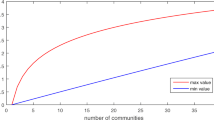Abstract
We develop a topology data analysis-based method to detect early signs for critical transitions in financial data. From the time-series of multiple stock prices, we build time-dependent correlation networks, which exhibit topological structures. We compute the persistent homology associated to these structures in order to track the changes in topology when approaching a critical transition. As a case study, we investigate a portfolio of stocks during a period prior to the US financial crisis of 2007–2008, and show the presence of early signs of the critical transition.
Access this chapter
Tax calculation will be finalised at checkout
Purchases are for personal use only
Similar content being viewed by others
References
Adler, R.J., Bobrowski, O., Borman, M.S., et al.: Persistent homology for random fields and complexes. Inst. Math. Stat. Collect. 6, 124–143 (2010)
Berwald, J., Gidea, M.: Critical transitions in a model of a genetic regulatory system. Math. Biol. Eng. 11 (4), 723–740 (2014)
Berwald, J., Gidea, M., Vejdemo-Johansson, M.: Automatic recognition and tagging of topologically different regimes in dynamical systems. Discontinuity Nonlinearity Complex. 3 (4), 413–426 (2015)
Carstens, C.J., Horadam, K.J.: Persistent homology of collaboration networks. Math. Probl. Eng. 2013, 1–7 (2013)
Chazal, F., Cohen-Steiner, D., Guibas, L.J., et al.: Gromov-Hausdorff stable signatures for shapes using persistence. In: Computer Graphics Forum (Proc. SGP 2009), pp. 1393–1403 (2009)
Chazal, F., de Silva, V., Oudot, S.: Persistence stability for geometric complexes. Geom. Dedicata 173, 193–214 (2013). doi:10.1007/s10711-013-9937-z
Cohen-Steiner, D., Edelsbrunner, H., Harer, J., et al.: Lipschitz functions have L p -stable persistence. Found. Comput. Math. 10, 127–139 (2010). doi:10.1007/s10208-010-9060-6
Edelsbrunner, H., Harer, J.: Persistent homology — a survey. In: Goodman, J.E., Pach, J., Pollack, R. (eds.) Surveys on Discrete and Computational Geometry. Twenty Years Later. Contemporary Mathematics, vol. 453, pp. 257–282. American Mathematical Society, Providence, RI (2008)
Edelsbrunner, H., Morozov, M.: Persistent homology: theory and practice. In: European Congress of Mathematics, Krakow, 2–7 July 2012, pp. 31–50. European Mathematical Society, Zürich (2012)
Fasy, B.T., Kim, J., Lecci, F., Maria, C.: Introduction to the R package TDA, arXiv:1411.1830 (2014)
Horak, D., Maletic, S., Rajkovic, M.: Persistent homology of complex networks. J. Stat. Mech. Theory Exp. 2009, 1–25 (2009)
Kaczynski, T., Mischaikow, K., Mrozek, M.: Computational Homology. Springer, New York (2004)
Khasawneh, F., Munch, E.: Chatter detection in turning using persistent homology. Mech. Syst. Signal Process. 70–71, 527–541 (2016)
Kramár, M., Levanger, R., Tithof, J., et al.: Analysis of Kolmogorov flow and Rayleigh-Bénard convection using persistent homology. Phys. D Nonlinear Phenom. 334, 82–98 (2016). ISSN 0167-2789, http://dx.doi.org/10.1016/j.physd.2016.02.003
Münnix, M.C., Shimada, T., Schäfer, R., et al.: Identifying states of a financial market. Sci. Rep. 2 (644), 1–6 (2012)
Nicolau, M., Levine, A.J., Carlsson, G.: Topology based data analysis identifies a subgroup of breast cancers with a unique mutational profile and excellent survival. Proc. Natl. Acad. Sci. 108 (17), 7265–7270 (2011)
Nobi, A., Sungmin, L., Kim, D.H., et al.: Correlation and network topologies in global and local stock indices. Phys. Lett. A 378 (34), 2482–2489 (2014)
Nobi, A., Maeng, S.E., Ha, G.G., et al.: Effects of global financial crisis on network structure in a local stock market. Phys. A Stat. Mech. Appl. 407, 135–143 (2014)
Scheffer, M., Bascompte, J., Brock, W.A., et al.: Early-warning signals for critical transitions. Nature 461 (3), 53–59 (2009)
Smerlak, M., Stoll, B., Gupta, A., Magdanz, J.S.: Mapping systemic risk: critical degree and failures distribution in financial networks. PLoS ONE 10 (7), e0130948 (2015). doi:10.1371/journal.pone.0130948
Acknowledgements
Research of Marian Gidea was partially supported by the Alfred P. Sloan Foundation grant G-2016-7320, and by the NSF grant DMS-0635607.
Author information
Authors and Affiliations
Corresponding author
Editor information
Editors and Affiliations
Rights and permissions
Copyright information
© 2017 Springer International Publishing AG
About this paper
Cite this paper
Gidea, M. (2017). Topological Data Analysis of Critical Transitions in Financial Networks. In: Shmueli, E., Barzel, B., Puzis, R. (eds) 3rd International Winter School and Conference on Network Science . NetSci-X 2017. Springer Proceedings in Complexity. Springer, Cham. https://doi.org/10.1007/978-3-319-55471-6_5
Download citation
DOI: https://doi.org/10.1007/978-3-319-55471-6_5
Published:
Publisher Name: Springer, Cham
Print ISBN: 978-3-319-55470-9
Online ISBN: 978-3-319-55471-6
eBook Packages: Physics and AstronomyPhysics and Astronomy (R0)




